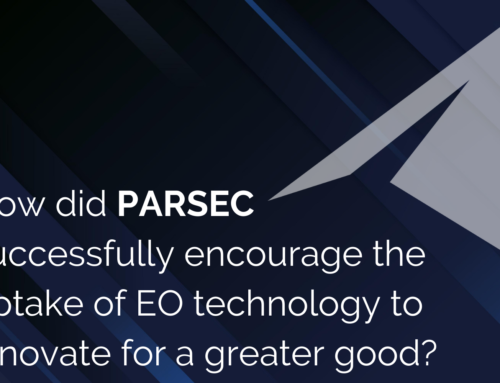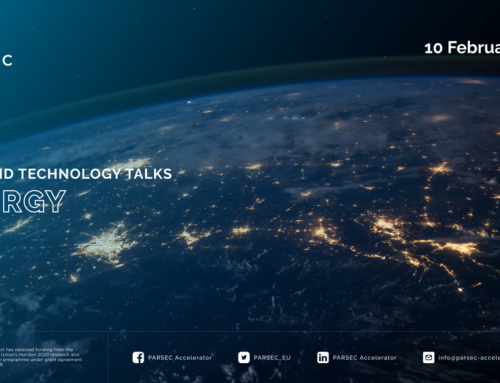The answer lies in Earth Observation’s extraordinary ability to provide you and your innovation with the bigger picture
What can Earth Observation technologies bring to the table to transform your entrepreneurial vision into a real-world success?
Here, we explain what “innovation fuelled by Earth Observation” can mean for your business.
![German North Sea coast-Sentinel Hub German North Sea coast. Contains modified Copernicus Sentinel data [2018], processed by Sentinel Hub](https://parsec-accelerator.eu/wp-content/uploads/2019/11/45987999755_f3eea138b7_o.jpg)
The PARSEC Accelerator is supporting the development of new products and services in the Food, Energy and Environment sectors, under the rubric “Innovation fuelled by Earth Observation”. So, what can Earth Observation (EO) technologies bring to the table to transform your entrepreneurial vision into a real-world success?
The answer lies in Earth Observation’s extraordinary ability to provide you and your innovation with the bigger picture, both literally and figuratively. It elevates your insight by allowing you to see things others can’t, from outside the box, or specifically, from outside our Earth.
Let’s start with the basics – what is Earth Observation? EO can be defined as the collection and analysis of information regarding our planet’s physical, chemical and biological systems. A wide range of technologies existing for collecting Earth Observation data; within PARSEC, the focus is on the use of satellites. Sophisticated imaging technologies mounted on satellites can provide us with a plethora of different types of information, which can be used to help us deepen our understanding of the condition of our planet, how it works and how we can improve it.
Images from weather satellites make regular appearances on our news channels, and thanks in large part to Google Earth, millions of people are now aware of the beauty and power of optical satellite imagery. Despite this popular appeal, relatively few industries make use of satellite data. Historically, getting hold of satellite imagery was both expensive and time-consuming, and – once acquired – required a great deal of technical know-how in order to get something useful out of it.
But things have changed quite dramatically in recent years. The EO industry is undergoing a sort of renaissance, thanks to the maturation and convergence of number of important enabling technologies including big data, cloud computing, the Internet of Things, deep learning and artificial intelligence, as well as miniaturisation and improvements in chip performance. A broader industrial movement known as “New Space” has developed new business models, offering private, low-cost access to space (e.g. SpaceEx, Blue Origin) and building small and light satellite constellations (e.g. Planet’s Doves). On top of this, the European Union’s Copernicus programme, operational since 2014 with its dedicated Sentinel satellites, generates over 1.5 terabytes of data every day, which is freely and openly available for use by citizens, scientists and businesses.
Taken together, these trends represent an enormous opportunity for boosting the productivity, innovation and competitiveness of European SMEs and start-ups, especially in emerging industries such as food, energy and environment.
Thanks to Copernicus, the cost of satellite data is no longer a major barrier, and although it’s still no walk in the park to extract insights from it, tools are available to make this much easier – including PARSEC’s very own “Big Data Toolbox”.
Businesses which were traditionally thought of as completely isolated from the space sector are learning that by teaming up with EO providers and leveraging EO data, they can enhance their products and services, set themselves apart and achieve their vision. Let’s take a look at what “Innovation fueled by Earth Observation” could look like in PARSEC’s target sectors of food, energy and environment:
Food: Applications related to agtech, smart agriculture, food security and the Common Agricultural Policy:
- Satellite data helps potato farmers in Belgium to improve the quality of their crops with less input costs
- Polish farmers optimise their use of fertilisers and pesticides thanks to Copernicus data
- Supporting Rwandan coffee farmers from across the globe with satellite data
Energy: Applications linked to cleantech, renewable energy, oil and gas:
- Managing hydropower production using satellite information
- Monitoring oil and gas pipelines from space
- Using satellites for monitoring solar energy production
Environment: Applications linked to climate change, air and water quality, forestry, the oceans, and other natural resources, environmental protection and conservation:
- Forestry management in Sweden
- Dredging in the Maldives
- Cracking down on illegal deforestation in Romania
This re-thinking of EO is driving innovation itself, improving people’s lives and helping us develop more sustainable ways of working. Both businesses and society as a whole are experiencing the tangible benefits of including EO in their arsenal when endeavouring to create value and overcome challenges.
The PARSEC Accelerator is uniquely positioned to support SMEs and start-ups who have a vision for innovation in the food, energy and environment sectors to benefit from the Earth Observation renaissance, and equip them with the tools they need to make the most of it.
The PARSEC Open Call 1 is accepting applications until the 20th of December – apply now!




